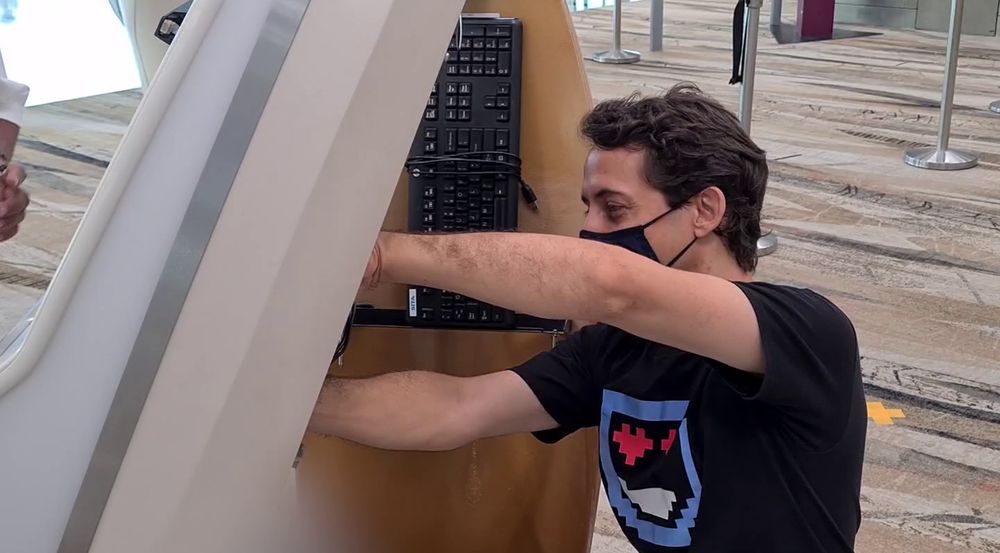
Creating a Safer Passenger Experience with Touchless Technology at Singapore Changi Airport
How one world-leading airport embraced touchless technology to give passengers peace of mind and reinforce their reputation as an industry trailblazer.
Background
Singapore Changi Airport is nothing short of iconic. Named the world’s best airport for eight consecutive years, it’s practically a tourist destination in itself.
But awards and waterfalls are no shield against a global pandemic. Like every other business in the travel industry, the airport quickly felt its impact as tourism ground to a halt. In response, Changi Airport Group immediately set out to make their customers' journeys safer and more hygienic, with minimal disruption to their experience.
As one of the busiest airports in the world, high touch points like check-in counters are hotbeds for viruses. With the demand for contactless interactions also rising among consumers, it’s no surprise the airport wanted to be the first in the world to offer a completely touchless check-in process. And they had no time to waste.
Thankfully, Pierre Hausheer, founder of Happymeter, and his team were keen to take on this urgent task. In less than a month, they developed a new contactless touch solution that could be retrofitted to any screen or self-service kiosk: the happyhover™.
The solution, which is powered by Neonode’s Touch Sensor Module, removes the need to touch surfaces by emulating a touch interface in mid-air.
Challenge
For this project, speed was critical. Changi Airport wanted to reassure passengers they were doing everything they could to minimize risk of infection quickly and the timeline was aggressive. Happymeter, a small independent manufacturer, barely had a working prototype when he first met with the Airport team. But unafraid to push boundaries, Pierre agreed to have one ready in less than a week.
“As a small entity, our strength is our agility and we were keen to show the Airport we could provide the speed they were looking for. We worked day-and-night and we managed to create two prototypes, one as a backup, by the end of the week. After that, things went even faster. Usually, a proof of concept (POC) would take months to develop, but that lasted about a week too. Next thing you know I’m on the phone to Neonode placing orders for 250 units,” says Pierre.
They needed something that was efficient, reliable, and could be deployed in no time. With a little help from Neonode’s support and sales teams Happymeter and Singapore Changi Airport were ready for the big roll out.

The solution
After record development and POC times, happyhover™, a plug-and play solution that could easily be retrofitted to existing kiosks, was officially born.
Based on advanced infrared technology from Neonode, the happyhover™ detects finger movements before users touch the screen. The system is non-intrusive (as easy as plugging in a USB mouse), and a thin sensor bar is placed just above existing screens to make them instantly touchless. The solution works with any input, including gloves, wet and greasy hands and long fingernails.
During its development, Pierre had some specific requirements in mind: “I wanted something based on mature technology that could be deployed quickly, but still be affordable. We also didn’t want to change or disrupt the customer experience too much. The idea was that some passengers might not even know the screens were touchless until they’re using it. Some people might also still want to touch the screen. It's not so much about preventing people from touching things, but giving them the choice, and reducing the amount of times we touch things around us,” he explains.
After exploring different technologies, including AI based solutions, Pierre decided Neonode’s optical reflective technology was the best option.
zForce (zero force) is Neonode’s optical sensing technology that’s built on infrared light, invisible to the human eye. It provides many benefits only optical technology can realize, such as pinpoint accuracy, high scanning frequency, and low latency. It also enables hyper intuitive in-air interactions, ranging from sweeping hand motions to multi-finger gesturing, as well as dynamic sensing of any object or environment.
“The supporting documentation for the technology was also really extensive. It convinced me that the technology was indeed mature but also that was the kind of company that cares about third party integrators.” adds Pierre.
Results
In two months, Happymeter successfully went from what was only an idea to the deployment of its new happyhover™ solution onto 200 self-service kiosks. The project had many other positive outcomes:
Singapore Changi Airport maintains world-class reputation for customer experience and technological trailblazers
Plug-and-play solution can be used for countless other applications
No personal information is stored or collected, protecting customers privacy
Consumers who wish to do so can still touch the kiosk displays, making customer adoption seamless
About Happymeter
Happymeter provides touchless solutions to reconcile hygiene with convenience and help ensure the safe resumption of economic activities. The team consists of engineers and experience designers who are dedicated to providing exceptional customer success. They’ve been working with touchless technology since 2019 (before the pandemic) and are based in Singapore.